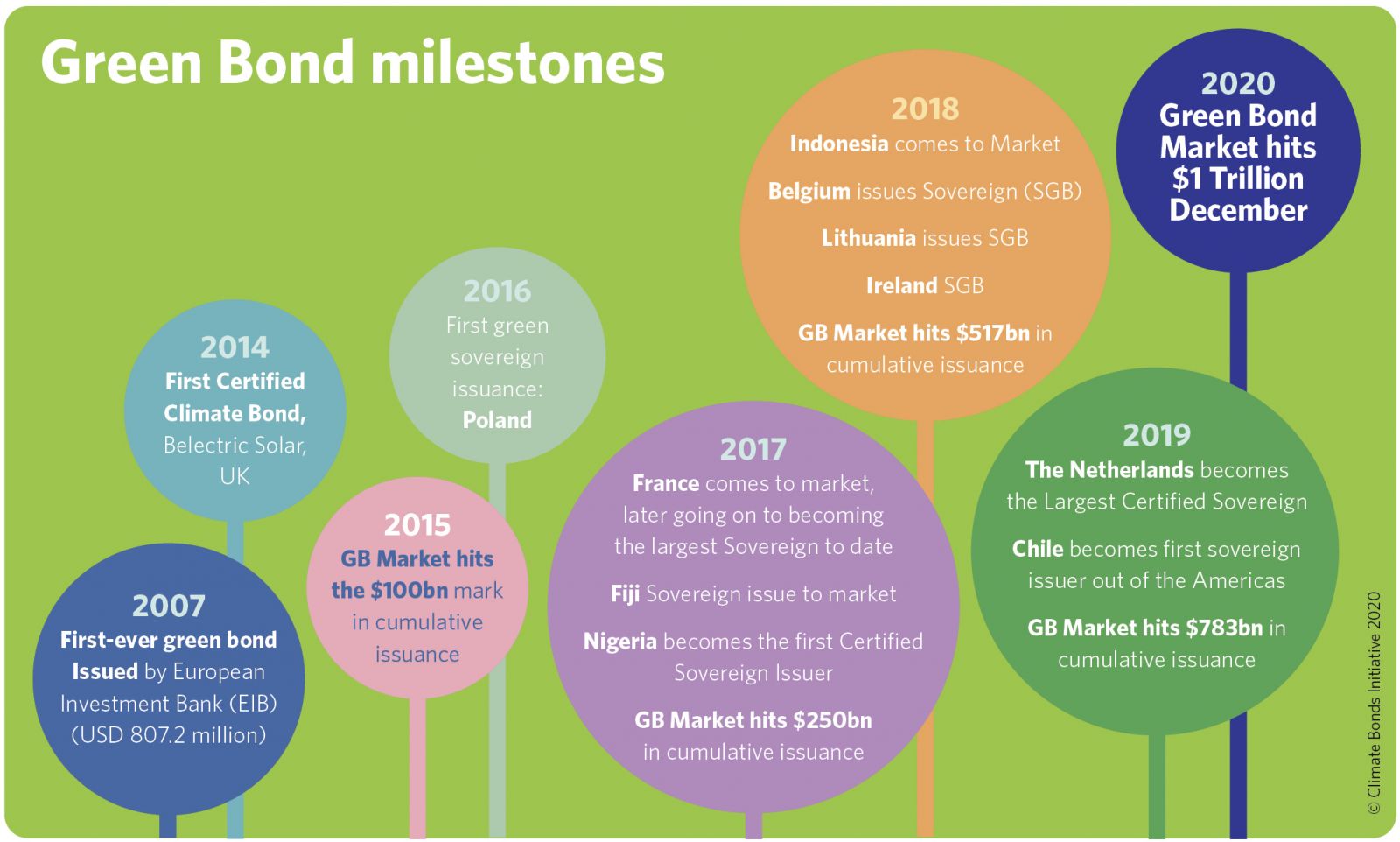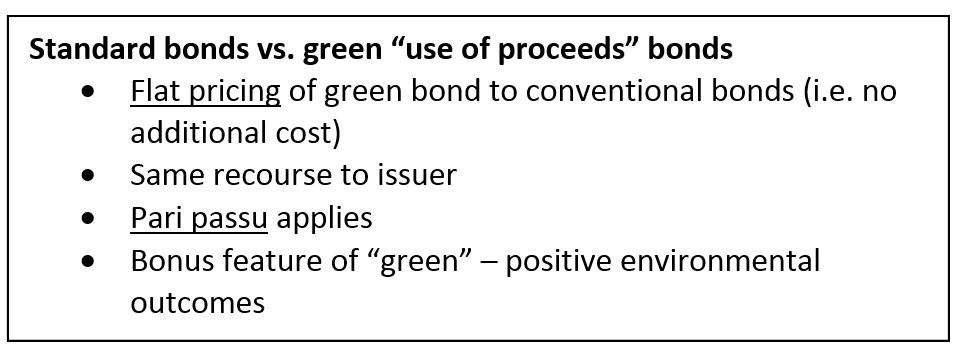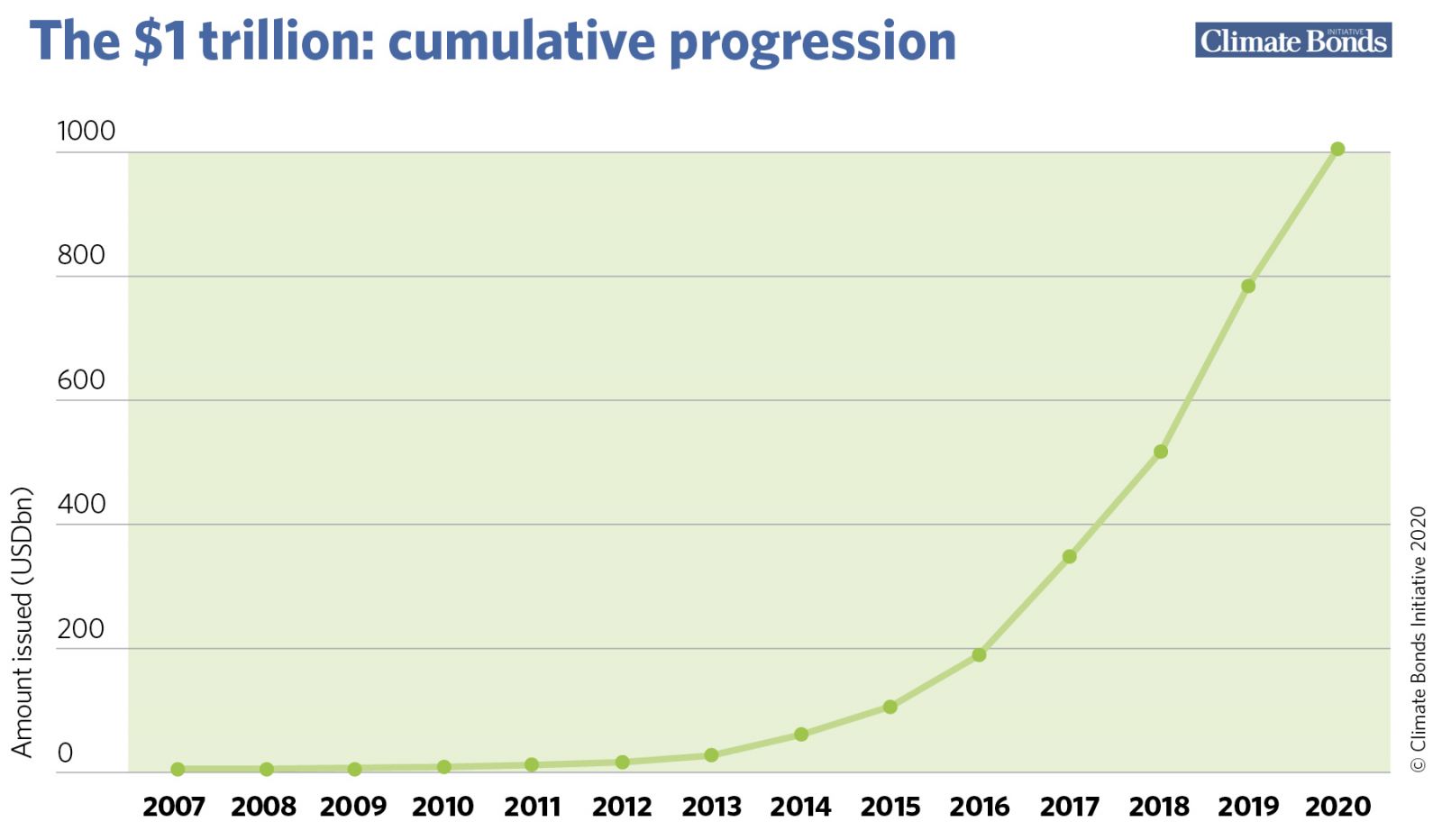Explaining Green Bonds
Helpful terminology
- Certified Climate Bonds
- Verification
- Independent review/ second party opinion
- Green Bond Principles: explained and link to website
Rapid growth of the green labelled market
The green bond market has seen exponential growth. It reached its most substantial milestone yet, with USD 1 trillion in cumulative issuance since market inception in 2007. The milestone was passed in early December 2020. You can see the updated cummulative totals on the Green Bond Market on our market widget on the homepage.
In the 13 years since market inception we have calculated the average annual growth rate at approximately 95%.
The very first green bond was issued in 2007 with the AAA-rated issuance from multilateral institutions European Investment Bank (EIB) and World Bank. The market starting to kick off in 2014 and since then each year has closed at record all time highs.
The wider bond market started to react after the first USD1bn green bond, which sold within an hour of issue, by IFC in March 2013. The November of 2013 there was a turning point in the market as the first corporate green bond issued by Vasakronan, a Swedish property company. Large corporate issuers include SNCF, Berlin Hyp, Apple, Engie, ICBC, and Credit Agricole.
The first green muni bond was issued by Massachusetts in June 2013. Gothenburg issued the first Green City bond in October 2013. US states are major green bond issuers, but issuers also include Province of Ontario, City of Johannesburg, and Province of la Rioja (Argentina). Local government green bonds continue to grow.
SolarCity (now Tesla) issued the first solar ABS in November 2013. The biggest ABS issuer is Fannie Mae. ABS includes solar ABS, green MBS, green RMBS, green CMBS, PACE ABS, auto ABS and receivables ABS.
By the end of 2015, the cumulative USD100bn mark had been reached with growth accelerating towards the trillion mark in the five years since. The milestone of USD100bn in annual issuance came to pass in November 2017 during COP23 in Bonn, providing a boost in market perception that green bonds were becoming a mainstream product and vital contributor to climate finance and reaching Paris Accord objectives.
An encouraging characteristic of the green finance market has been the remarkable growth of green debt instruments including green loans and sukuk. Green instruments have orignated from a record sixty seven nations and multiple supranational institutions.

Using debt capital markets to fund climate solutions
Green bonds were created to fund projects that have positive environmental and/or climate benefits. The majority of the green bonds issued are green “use of proceeds” or asset-linked bonds. Proceeds from these bonds are earmarked for green projects but are backed by the issuer’s entire balance sheet. There have also been green "use of proceeds" revenue bonds, green project bonds and green securitised bonds.
Types of green bonds
| Type | Proceeds raised by bond sale are | Debt recourse | Example |
|---|---|---|---|
| "Use of Proceeds" Bond | Earmarked for green projects | Recourse to the issuer: same credit rating applies as issuer's other bonds | EIB "Climate Awareness Bond" (backed by EIB); Barclays Green Bond |
| "Use of Proceeds" Revenue Bond or ABS | Earmarked for or refinances green projects | Revenue streams from the issuers though fees, taxes etc are collateral for the debt | Hawaii State (backed by fee on electricity bills of the state utilities) |
| Project Bond | Ring-fenced for the specific underlying green project(s) | Recourse is only to the project's assets and balance sheet | Invenergy Wind Farm (backed by Invenergy Campo Palomas wind farm) |
| Securitisation (ABS) Bond | Refinance portfolios of green projects or proceeds are earmarked for green projects | Recourse is to a group of projects that have been grouped together (e.g. solar leases or green mortgages) | Tesla Energy (backed by residential solar leases); Obvion (backed by green mortgages) |
| Covered Bond | Earmarked for eligible projects included in the covered pool | Recourse to the issuer and, if the issuer is unable to repay the bond, to the covered pool | Berlin Hyp green Pfandbrief; Sparebank 1 Bolligkredit green covered bond |
| Loan | Earmarked for eligible projects or secured on eligible assets | Full recourse to the borrower(s) in the case of unsecured loans. Recourse to the collateral in the case of secured loans, but may also feature limited recourse to the borrower(s). | MEP Werke, Ivanhoe Cambridge and Natixis Assurances (DUO), OVG |
| Other debt instruments | Earmarked for eligible projects | Convertible Bonds or Notes, Schuldschein, Commercial Paper, Sukuk, Debentures |
Benefits for issuers outweigh costs
Green bonds have some additional transaction cost because issuers must track, monitor and report on use of proceeds. However, many issuers, especially repeat green bond issuers, offset this initial cost with the following benefits:
- Highlights their green assets/business
- Positive marketing story
- Diversify their investor base (as they can now attract ESG/RI specialist investors)
- Joins up internal teams in order to do the investor roadshow (environmental team with Investor relations and other business)
See the full list of green bonds issued here
Green Bonds are standard bonds with a bonus "green" feature
The green “use of proceeds” bond market has developed around the idea of flat pricing - where the bond price is the same as ordinary bonds. Prices are flat because the credit profile of green bonds is the same as other vanilla bonds from the same issuer. Therefore, green bonds are pari pasu to vanilla issuance.

